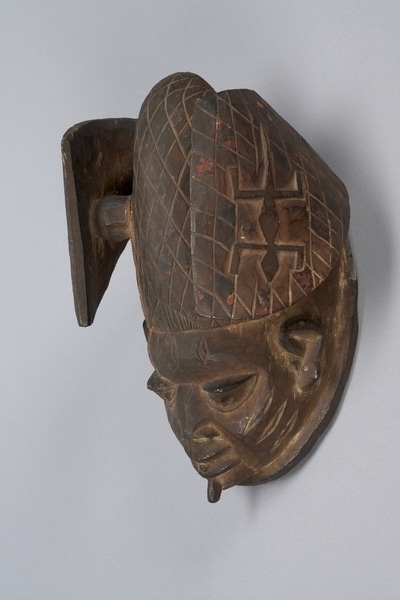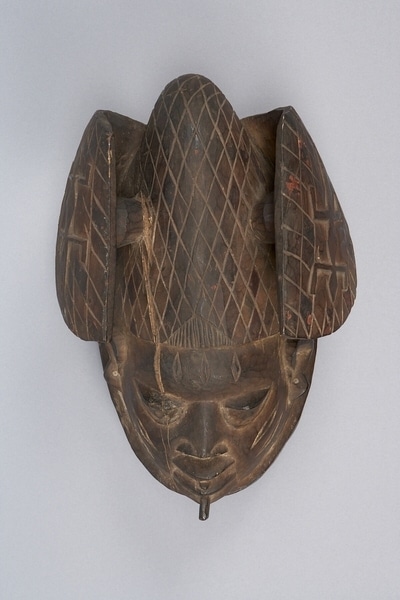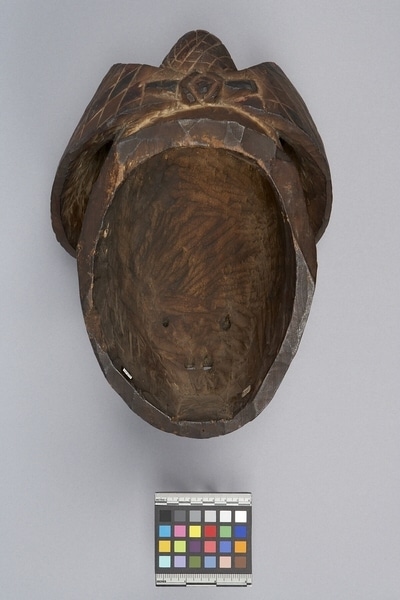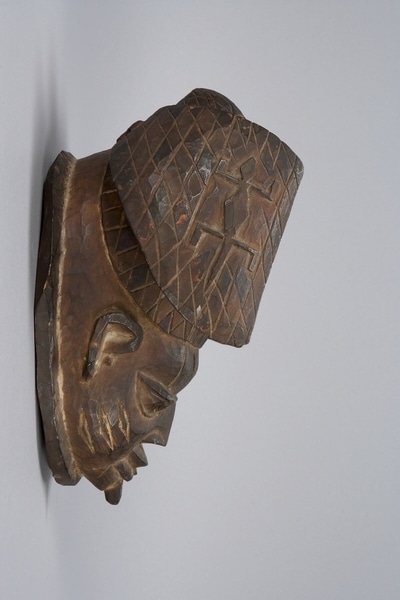Gelede Mask Item Number: 1373/70 from the MOA: University of British Columbia




Description
Dark brown coloured oval-shaped mask with two protruding panels on the top. The lower half is a human face mask with protruding eyebrows, cut-out eyeballs, small wide nose with cut-out nostrils, closed mouth and small chin protrusion. The top half is somewhat cone-shaped, decorated with cross-hatching. Protruding from either side of the head on thick posts are carved panels with overall cross-hatching detail and a central lizard-like design carved into the wood.
History Of Use
The gélède mask is worn more like a headdress, on top of the head, by male dancers. The masks are worn during Yoruba Gelede festivals which honour women, both living and dead, in particular the powerful "Mothers" (awon iya wa), a group that includes female ancestors and deities, as well as elderly women of the community. When dancers perform the Gelede dance they are displaying the powers of their female ancestors, who are considered to the beginning of the nation, makers of community and the protectors of children. They have the ability to affect the wellbeing of individuals or the community in positive and negative ways. The Gelede ceremony is divided into two parts: the efe, which takes place at night and features a humorist praying for the community, and the ijo osan, the daytime dance that is commonly referred to as Gelede.
Iconographic Meaning
One narrative for the origin of the Gelede dance is that after Yemoja, the water goddess and mother of all spirits, performed a spirit dance by the river she gave birth to two children. Her daughter was a dancer and was called Gelede because of her weight; Yemoja’s son was called Efe because he was a humorist. The names of the children and their traits could then inform the parts of the Gelede ceremony. Female gelede masks are larger and are used for dancing, and the efe nighttime ceremony involves a humorist. The lizard, appearing on each side of the head-covering, is a common animal motif in Yoruba culture. Lizards are usually used in rituals and burnt for medicinal purposes, so are commonly connected to orisa (deities). The use of lizard motifs on the mask could indicate this mask represents a gelede society member, like a chief or king, who partakes in orisa practice.
Cultural Context
Gelede festival dances.
Item History
- Made in Nigeria
- Owned by Helen Purkis before May 30, 1989
- Received from Helen Purkis (Donor) on May 30, 1989
What
Who
- Culture
- Yoruba
- Previous Owner
- Helen Purkis
- Received from
- Helen Purkis (Donor)
Where
- Holding Institution
- MOA: University of British Columbia
- Made in
- Nigeria
When
- Ownership Date
- before May 30, 1989
- Acquisition Date
- on May 30, 1989
Other
- Condition
- fair
- Accession Number
- 1373/0070